
How Andrew Tate gains influence through his media literacy
Despite getting banned several times on a wide variety of online platforms, Andrew Tate's controversial content continues to gain online popularity. This article analyses Andrew Tate’s online presence, to show how he deploys his media literacy to spread his ideas.
Introducing Andrew Tate
Andrew Tate is an American-British self-proclaimed online guru and former professional kickboxer. Following his kickboxing career, he started posting content on social media, leading him to become an (in)famous far-right social media influencer.
The content that Tate puts out is often considered to be misogynistic and aggressive. Because of this, Tate is banned on several social media platforms. Unsurprisingly, Tate has a vast history of getting banned. In 2016, Tate got asked to star in Big Brother, though he was removed from the show after 6 days of participation because of several homophobic and racist comments on Twitter and because of the release of a video where Tate was hitting a woman with a belt. In August 2022, Tate was banned not only from Big Brother and Twitter, but also from Facebook, Instagram, TikTok, YouTube, Discord, Airbnb, and Uber. In December 2022, Tate has been detained in Romania as part of a human trafficking and rape investigation.
Though ''the media machine'' – as Tate would call it – makes it difficult for him to spread his message, he has been quite successful. After getting banned on conventional social media platforms, he and his audience moved to platforms with less severe moderation policies, such as Gettr and Rumble. Until now, Tate is going against the odds and continues to spread his ideologies on these platforms. It is important to note that Tate has recently reappeared on Twitter, after Elon Musk decided to rehabilitate banned Twitter users to create a bastion of freedom of speech in November 2022 (van Dijk, 2022). This, of course, gives Tate even more online space to promulgate his ideology.
Escaping the Matrix
Whereas almost everyone in the world believes that Tate is banned for his misogynistic comments on social media, he himself would like to disagree. As he said in a livestream on Rumble on the 6th of September 2022: ''I am not banned for my comments on women but my comments on other things that people did not want to hear.''
The ''things that people do not want to hear'' that Tate talks about concern the matrix. The matrix – a term derived from the eponymous movie – functions as a metaphor to frame the power of a political elite that uses media to practice control over the world. This idea dominates Tate's online discourse and the sheer amount of times that Tate references or mentions the movie The Matrix demonstrates that the movie is a huge inspiration to him. Even when Tate got arrested in December 2022, he claimed that it was the work of the matrix.
Interestingly, Tate is not the first to use The Matrix as inspiration. The discourse around The Matrix is common in the online global New Right community. In ''Alternative Influence: Broadcasting the Reactionary Right on YouTube'', Lewis (2018, p. 3) introduces the Alternative Influence Network (AIN), an ''assortment of scholars, media pundits and internet celebrities who use YouTube to promote a range of political positions (…)''. The AIN frequently refers to ''taking the red pill'' – a term from The Matrix which is used in a scene where the protagonist finds out about the Matrix system – as a process of destabilization from previous worldviews. The resemblance with Tate’s discourse is obvious. Furthermore, upon engaging with Tate's content, it will quickly become clear that he believes he escaped the matrix, and that he now sees it as his duty to free other people.
In this article, I want to take a closer look at how Tate is propagating his idea of the matrix. First, I want to demonstrate how Tate attempts to spread his beliefs by waging a discursive battle for meaning. Second, I will look at the uptake of his content to find out if Tate is succeeding in his attempts. Third, I will analyze Tate's posts considering some influencer tactics such as authenticity, intimacy, and collaborations. Lastly, I will highlight the metapolitics conducted in Tate's propagation. These aspects combined will provide a broad framework on how Tate is gaining online influence and spreading his idea of the matrix. For my analysis, I gathered data from Tate's accounts on Gettr, Rumble, and Twitter over a period of three months, September, October, and November 2022.
Waging a discursive battle
Language is an important political tool. As Fairclough (2003, p. 22) stated:
''Processes of cultural and discursive intervention (…) can be seen as attempts to change discourses on the assumption that changing discourses will, or may, lead to changes in other elements of social practices through processes of dialectical internalization.''
In other words, changes in discourse lead to changes in other elements of social life. In politics, discourse can help normalize certain ideas while actively discrediting ''the other''.
Tate has perfectly understood this. He is constantly (discursively) fighting to make his ideas on the matrix normalized and prevalent amongst his followers. This process is also called a discursive battle for meaning, where one uses discursive resources to realize temporary fixations of meaning (Maly, 2016). In the case of Andrew Tate, most of his battle consists of convincing his followers that the matrix is real. Figure 1 shows a Gettr-post from Tate where he directly tells his audience that the matrix controls them.

Figure 1: Gettr post by Andrew Tate
In Figure 2, Tate explicitly mentions the matrix. This post simultaneously functions as an invitation to believe in the matrix and escape from it. These two Gettr-posts perfectly illustrate how Tate is trying to convince his followers of his ideas.

Figure 2: Gettr post by Andrew Tate
Tate is constantly (discursively) fighting to make his ideas on the matrix normalized.
Tate not only wages this battle on social media, however. Tate recently launched a website that is - according to the website itself - a ''fully independent learning platform designed to break people free from the matrix.'' On this website, Tate is constantly referencing The Matrix movie (see for example Figure 3)
On the bottom of the webpage, website visitors can choose between the blue pill - ''Go to Netflix'' - and the red pill - ''Join the Real World''. Clicking on the blue button will redirect you to the Netflix website, while the red button directs users to the sign-up form for the website. Pushing the red button will thus help you join ''the real world'' - as the name of the website states - and escape the matrix.
Note that the red pill indexes Tate's political position. As aforementioned, the AIN refers to the term ''taking the red pill'' from the Matrix movie as a metaphor for a process of destabilizing from previous worldviews. Tate's usage of a red pill as a gateway to ''the real world'' is thus emblematic of his participation in the online global new right community.
Figure 3: Screenshot from Tate's website
Now, suppose one would take the blue pill. What exactly does this blue-pilled world look like? As mentioned above, Tate’s matrix discourse is a metaphor to frame a political elite that is controlling the world in biased ways. According to Tate, this elite practices their control through institutions like schools, the news, or the media. Tate tends to call people inside the matrix ''enslaved'', referring to the weakened state in which people living inside the matrix supposedly find themselves. Furthermore, Tate claims that when one is inside the matrix, thus under influence of this political elite, one is kept from the information that makes you rich, strong, and smart. Tate suggests that this is dangerous since it refrains one from succeeding in life.
By continuously mobilizing an ''us'' (Tate and his followers) versus ''them'' (the people controlling the Matrix) discourse, Tate attempts to convince his followers of the danger that the matrix poses. He then acts on the fear of his followers – showing a way out of the matrix – to get his followers to side with Tate (see Figure 4). This ''us-versus-them-discourse'' is the main element of Tate’s discursive battle for meaning, and his main attempt at normalizing his idea of the matrix.
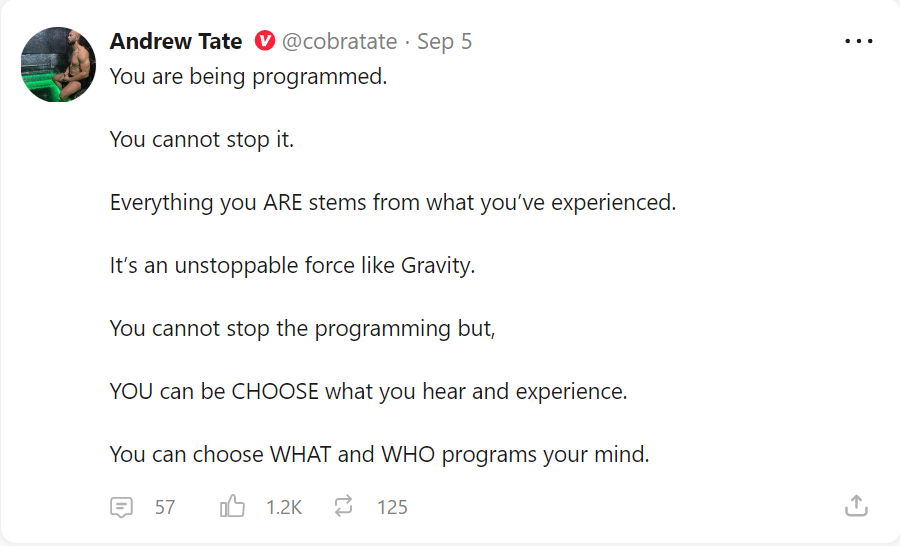
Figure 4: Andrew Tate indirectly inviting his followers to let him ‘’program their minds’’ to escape the Matrix
Uptake
Andrew Tate wages a discursive battle for meaning with the goal to convince his followers of his ideas on the matrix. Tate does this by continuously mobilizing an ''us-versus-them-discourse'', warning followers of the matrix, and requesting his followers to join him in his fight against the matrix. And this discourse works. A lot of his followers seem to have adopted his ideas on the matrix. Figure 5 shows two of Tate’s followers’ responses to his Gettr-posts. ''It’s time to escape'' and ''Well I can’t wait to escape'' clearly illustrate that his followers adopted the idea of the matrix.
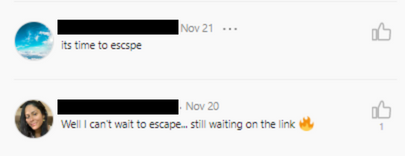
Figure 5: Responses of Tate's audience on Twitter
More importantly, one of Tate’s followers’ profiles has a considerable number of references to Andrew Tate and The Matrix (Figure 6). This user’s profile makes numerous references to the movie (header, profile picture, bio, location, etc.), while his handle (@TeamTate) and profile name ''TeamTate (Neo)'' refer to Andrew Tate. This profile is thus emblematic of Tate’s influence on his followers. His attempts at normalizing the idea of the matrix have worked.
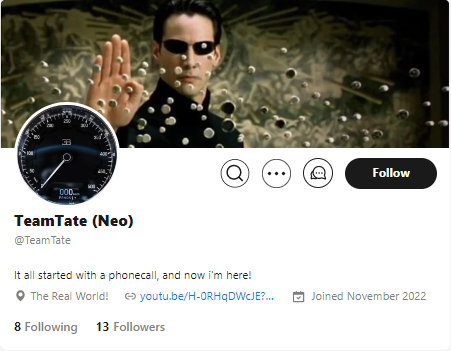
Figure 6: Twitter profile of one of Tate's followers
Blending the authentic with the aspirational
As I have illustrated above, Tate succeeds in convincing his followers of his ideas on the matrix through his discursive battle for meaning. However, this discursive battle is not the sole cause of his online success, Tate’s media literacy and knowledge of influencer tactics play a crucial role in this as well.
Tate's Message consists of a carefully crafted image of himself that perfectly blends staged authenticity and aspiration
In our current age, the way politicians, activists or political influencers look, speak, and perform is just as important as the literal discourse on ''political issues'', This communication of identity conducted by the politician, activist, or political influencer – Andrew Tate in this case – is also called ''Message'' (Lempert & Silverstein, 2012). Message is multimodal, as it concerns speech, clothing, staging, gesture, and even pronunciation (Lempert & Silverstein, 2012). New media and its increasing focus on communicative performance have made Message crucial to the propagation of one’s ideas and ideologies. However, new media have also changed Message. To produce Message in a hybrid media system (Chadwick, 2017), knowledge of digital and algorithmic culture is extremely important. Considering Tate's usage of influencer tactics in producing his Message, one can assume that Tate possesses digital and algorithmic knowledge.
Tate's Message consists of a carefully crafted image of himself that perfectly blends staged authenticity and aspiration. In other words, Tate portrays himself as an authentic person while simultaneously showcasing his ''desirable'' life. Hereby, he combines several influencer tactics. According to Lewis (2018), influencers establish a sense of credibility through authenticity. ''Being authentic'' is a highly effective way of building influence. Figure 7 illustrates how Tate creates authenticity online. By posting pictures of him doing everyday activities and sports, Tate shows a much more ''human'' side of him.
It is important to note that Tate performs authenticity here, rather than showing true authenticity. According to Gaden and Dumitricia (2015), political figures portray themselves as ''unmediated'' on social media to extend their reach and strategically attract voters and followers. They, therefore, speak of ''strategic authenticity'', where authenticity is staged and performed for strategic purposes. As is the case with Tate, his staged authenticity – performed through posting pictures of him doing sports, for example – facilitates greater credibility online, which helps Tate spread his ideas. Performing authenticity on social media, therefore, is a purely strategic move.
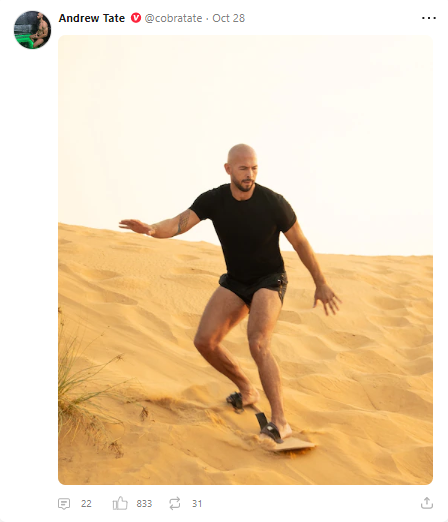
Figure 7: Andrew Tate sandboarding
Tate takes an interesting spin on authenticity, though. Most influencers combine authenticity with relatability (Lewis, 2018). Tate, however, performs authenticity while simultaneously creating an aspirational brand. More often than not, Tate showcases his wealth and success online (see Figure 8). Big boats, private jets, and expensive cars are commonplace objects in Tate’s world.
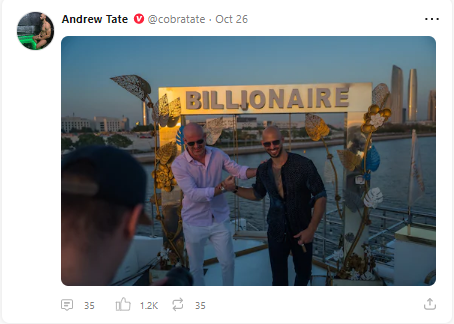
Figure 8: Andrew Tate posing in front of a ''billionaire'' sign
Besides displaying his wealth, Tate is constantly showing off his strength and masculinity, mostly through fighting videos (see Figure 9) and talking loudly in videos to assert dominance. Projecting oneself as hypermasculine is popular in the male far-right influencer community (Lewis, 2018). It functions as a form of self-branding, which is extremely important in influencer culture. Such a cultus of the body is not new, it has a vast history within the far-right community. In Tate’s case, he is branding himself as extremely wealthy, strong, and successful – a ''success coach'' so to say – and in doing so he creates an aspirational image of himself.
Interestingly, this aspirational image is in direct correlation with his matrix discourse. As aforementioned, Tate claims that the political elite – which controls the matrix – keeps people weak, poor, and dumb. The image that Tate crafts of himself online is the direct opposite of this, which is the same success that he claims awaits people once they escape from the matrix. His personal branding, then, substantiates and strengthens his matrix discourse.
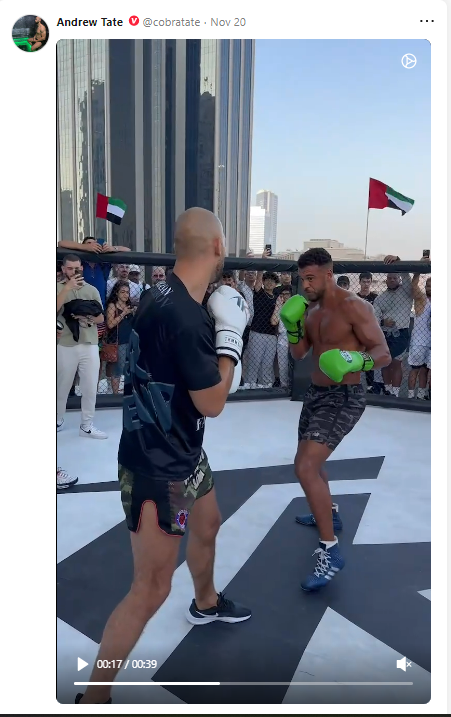
Figure 9: Video of Andrew Tate fighting posted on Gettr
Tate's personal branding substantiates and strengthens his matrix discourse.
The staged ''aspirational but authentic'' identity that Tate claims is an interesting but effective mix. It blends ''the everyday'' with ''the unattainable''. This mix is also what constitutes Tate’s entire Message. With his ''aspirational but authentic'' brand, Tate portrays himself as a normal person who rose to extraordinary heights in terms of success, wealth, and strength after escaping from the matrix. Hereby, Tate creates the illusion that incredible wealth and success are waiting for you once you escape from the matrix. Obviously, the idea of wealth is extremely attractive to many. Because of this, Tate’s Message could incentivize his followers to believe in the matrix.
Using the media to his advantage
According to Lempert & Silverstein (2012), mediatization and the mass media are crucial for one’s Message. Mass media help report one’s Message but also take part in constructing Message. Although Andrew Tate does not have mass media on his side (see Das, 2022; Thorsberg, 2022; Van Boom, 2022), he cleverly uses the resources available to him to strengthen his Message. Tate’s Twitter account is a perfect example of this. Tate only retweets posts that vow for Tate and his ideas (see Figure 10). Thus, Tate makes use of the affordances of digital media to make salient those elements of his message that he wants to be visible.
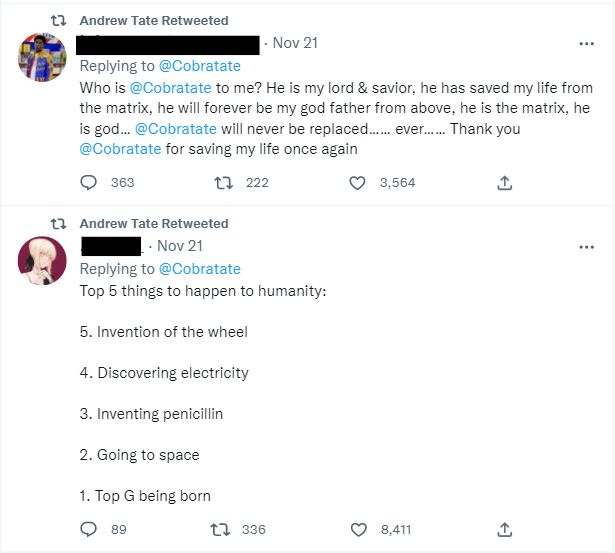
Figure 10: Retweets by Andrew Tate
By highlighting other people’s praise of him, Tate reinforces and strengthens the aspirational image of himself that he already started to create on his own. Tate balances the scrutiny of the mass media with his own audience’s praise. This strengthens the community of his followers and consequently helps Tate gain influence over his audience.
Metapolitics and the global new right community
Of course, Andrew Tate does not operate on his own. Tate is an important character in the global new right community and frequently collaborates or interacts with other members of that community. Collaborations ''cultivate a sense of loyalty'', as Lewis (2018, p. 21) puts it. In other words, collaborating with other online influencers that endorse the same ideas as Tate can amplify the influence and believability of his content.
On October 18th, 2022, Andrew Tate collaborated with Layah Heilpern, an online content creator and author, with a Twitter following of almost 400k. In their collaboration, Heilpern interviewed Andrew Tate about money, masculinity, and women. On her own social media, Heilpern does not shy away from posting about her political orientation, besides, she is an active endorser of Tate’s idea on the matrix (see Figure 11).

Figure 11: Tweet by Layah Heilpern
Another example: on October 25th, 2022, Andrew Tate posted a livestream on Rumble. This livestream got over 1.8 million views, which is exponentially more than many of his other Rumble-posts, which already signifies the reach that these types of collaborations have. In this livestream, Tate appears on screen together with several other online figures, one of which is Stephen Deleonardis (@SteveWillDoIt).
Deleonardis is highly active on social media, where he mostly endorses his political views. His Instagram immediately shows three pinned photos – which will stay on the top of his profile as long as he keeps them pinned -, one of which is a selfie with Donald Trump captioned ''The next president of the United States of America. Eat my sack you liberal fucks'' (see Figure 12). Also on his other social media accounts, Deleonardis is constantly expressing his right-wing views. By collaborating with people who endorse the same ideas as Tate, he cultivates more credibility and influence online. These collaborations can also create pathways of radicalization (Lewis, 2018), since Tate’s collaborations with these other online figures expose his audience to the broader new right network. This, in time, can lead Tate’s followers to increasingly engage with online global new right discourse and become acquainted with the discourse around the matrix.
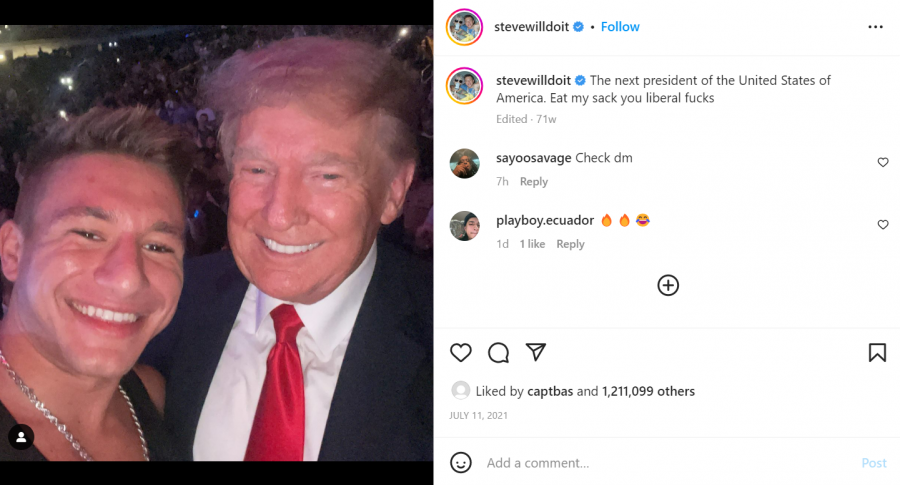
Figure 12: Instagram post by Stephen Deleonardis
Tate increases his online credibility by collaborating with like-minded people, exposing his audience to more people endorsing the same views as Andrew Tate.
Besides doing collaborations, the global new right community also supports Tate through other digital practices. One of which is metapolitics. According to Maly (2022), metapolitics is at the heart of global New Right activism. At its core, metapolitics is an ''ideological project set up to achieve cultural hegemony'' (Gramsci, 1971, as cited in Maly, 2019). In other words, metapolitics is metalinguistic talk about politics conducted to achieve new definitions of normality. In the hybrid media system, digital media affordances are used to conduct metapolitics. This is what Maly (2019) calls ''metapolitics 2.0''. Here, digital media is used to have a voice, express ideas, and normalize extremist discourse. This is often done by followers of a certain person or movement, through memes or trolling, as is the case with Andrew Tate.
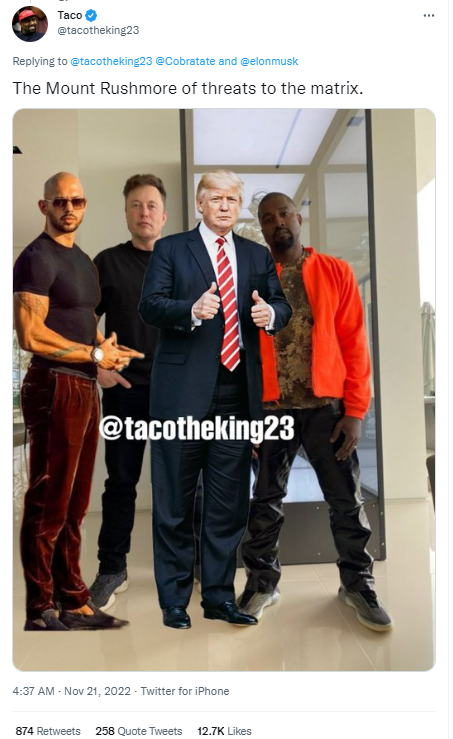
Figure 13: Meme posted by @tacotheking23 on Twitter
Figure 13 shows a meme posted by @tacotheking23 on November 21st, 2022. The meme is an edit of a picture of Kanye West and Elon Musk. In the picture, Andrew Tate and Donald Trump are edited in as well. The meme was posted with the caption: ''The Mount Rushmore of threats to the matrix.'' Instantly, it becomes clear that this user is aware of Tate’s ideas on the matrix and also endorses these ideas.
This meme, and any other meme for that matter, re-recontextualizes the idea of the matrix, which changes the uptake by the audience. The meme brings the idea of the matrix into the mainstream, normalizes these discourses, and facilitates influence to a broader audience. The post by @tacotheking23 is a perfect example of the ''memetic warfare'' (Maly, 2019) conducted in right-wing online discourse, and thus also Andrew Tate's propagation of the matrix.
Deploying media literacy
This article analyzed Andrew Tate's online presence to demonstrate how Tate deploys his media literacy to gain influence and spread his ideas. Data shows how Tate wages a discursive battle for meaning by continuously mobilizing an ''us-versus-them-discourse'', which – as was shown – causes his followers to believe in the matrix. Furthermore, it was illustrated how Tate uses Message, influencer tactics, and metapolitics 2.0 to gain influence in the online world. It can be concluded that Andrew Tate knows exactly how to use (social) media to spread his message and gain influence online. His media literacy has led him to become one of the most influential people on the internet. Despite getting banned repeatedly, Tate is still going against the odds: deploying his media literacy to convince people of the matrix.
References
Boom, D. van. (2022, November 22). Andrew Tate Is Back on Twitter. Here’s Why He’s Still Banned Almost Everywhere Else. CNET.
Chadwick, A. (2017). The hybrid media system. Politics and power. Oxford University Press.
Das, S. (2022, August 7). Inside the violent, misogynistic world of TikTok’s new star, Andrew Tate. The Guardian.
van Dijk, W. van. (2022, november 25). Elon Musk rehabiliteert verbannen Twitteraars. NRC.
Fairclough, N. (2003). Political Correctness’: the Politics of Culture and Language. Discourse & Society, 14(1), 17–28.
Gaden, G., & Dumitrica, D. (2014). The ‘real deal’: Strategic authenticity, politics and social media. First Monday.
Lempert, M., & Silverstein, M. (2012). Creatures of politics: Media, message, and the American presidency. Indiana University Press.
Lewis, R. (2018). Alternative influence: Broadcasting the reactionary right on YouTube.
Maly, I. (2022): Guillaume Faye’s legacy: the alt-right and Generation Identity. Journal of Political Ideologies.
Maly, I. (2016). ‘Scientific’ nationalism: N-VA and the discursive battle for the Flemish nation. Nations and Nationalism 22(2), 2016, 266-286.
Maly, I. (2019). New right metapolitics and the algorithmic activism of Schild & Vrienden. Social Media+ Society, 5(2),
Tate, A. (2022a, October 18). ANDREW TATES MOST ICONIC INTERVIEW ON MONEY, MASCULINITY & WOMEN ft LAYAH HEILPERN [Video]. Rumble.
Tate, A. (2022b, September 6). EMERGENCY MEETING EPISODE 3 - THE 41 TENETS OF TATEISM [Video]. Rumble.
Tate, A. (2022c, October 7). EMERGENCY MEETING EPISODE 6 - Welcome to The Real World [Video]. Rumble.
Tate, A. (2022d, October 25). THE DAM OF CENSORSHIP IS BREAKING. Rumble.
Thorsberg, C. (2022, August 30). Andrew Tate isn’t just another misogynist with an online following. Here’s why you need to pay attention. Grid News.
